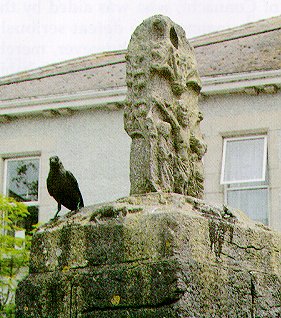 CARNAUN NATIONAL SCHOOL
CARNAUN NATIONAL SCHOOL 
Tabernacle / Lantern Style Market
Cross
Unique In Ireland!
By Prof. Etienne Rynne
In Athenry's
Market Square is an unusual monument consisting of a steeply stepped pyramidal
base on which is set a carved socket-stone with an upright, rectangular-sectioned
sculpted stone on its top. Known as the Market Cross, this monument does
not really present the appearance of being a cross, despite the carving
of a crucifixion on one face of the upright stone. It is, in fact, the
last remnants of a fine Late Medieval Gothic cross of Tabernacle or Lantern
type. Such crosses, dating from the 15th century perhaps mainly
from the second half of that century, arc well-known in Britain (mainly,
in England, Cornwall and south Wales) in Northern France, in Germany, and
elsewhere in Gothic Europe - but for Ireland the Athenry monument is a
unique example such crosses get their name because instead of a transom
as a cross-head they have a rectangular swelling, generally with a pointed
roof-like top, which has an appearance vaguely resembling a lantern or
tabernacle. Almost invariably such crosses have a long, tapering generally
plain but chamfered shaft set into a sculpted socket which is on top of
a large and often quite high stepped pyramidal base. These crosses are
not crucifixes though most bear a crucifixion scene carved on the main
face of the tabernacle-like part.

The Athenry market cross fits into this general pattern, only the
long shaft and roof-like portion now missing. The pyramidal base consists
of four steep-steps, well built of large stones (also a low, step-like
surround of concrete at ground-level). Excluding the concrete surround,
the base measures 2.46m. by 2.38m. at its bottom, and the steps, from the
bottom upwards, measure 48 cm., 49 cm., 44 cm. and 52 cm. in height, giving
an overall height of almost ( just over 6 ft.). On the top of the stepped
base is set a virtually square stone, 40 cm. by 41 cm. and 26m. high, clearly
the original socket-stone for the now-missing shaft. Its lower 14 cm. is
vertical and plain, while its upper portion is sloping and carved with,
among other things, a stag, a winged quadruped, fighting and other dog-like
animals, an angel holding a long scroll diagonally across its body, and
two opposed jani (mythological quadrupeds with single horns which they
could swivel around) with interlocked necks; these latter resemble those
on the doorway into Clontuskert Abbey, near Ballinasloe, dated to 1471,
which thus helps date the Athenry cross. The upright stone now set into
the socket-stone is the tabernacle / lantern-like part of the cross, though
now missing its top and bottom. Enough of it remains to show that it was
a finely-carved piece, with two wide faces (the front and the back) and
two narrower ones on the side. All faces are recessed the recesses surmounted
by crocketted and pinnacled arched two over the front recess and one over
each of the others. The front recess contains a carved cruciform scene,
with Our Lady and St. John standing on either side of the cross. The back
recess contains a carving of the Madonna and Child, while the two side-recesses
are flat and plain - such undecorated recesses are quite common on crosses
of this type and were almost certainly intended for a painting of a saint
or religious scene or symbol; indeed, the whole cross-head and its socket-stone
may well have been coloured originally
The proportions of the sculpted heads to the
tapering shafts of a sample of such crosses varies greatly, but averages
out at about 1:3. As the incomplete head of the Athenry cross is 69 cm.
high, and was originally about l0 cm. more, it can be estimated that the
shaft would probably have been something in the region of 2.25 m.
high. Judging from the measurements of the base of the cross-head (30 cm.
by 20 cm.) and those of the top of the socket-stone, the shaft would have
been about 25 cm. by 15 cm. at its top and 40 cm. by 41 cm. at its bottom.
With such a shaft the cross would look something like the accompanying
drawing. To restore the Athenry market cross is a definite
possibility and would be a relatively easy matter. The result would be
a unique, for Ireland, and an outstandingly impressive monument.
While the overall height would be in the region of 5m. this would not be
excessive for monuments of its type, many of which are considerably higher
(as also are many of Ireland's high Crosses).
Return to the top
SCOIL NÁISIÚNTA
CARNÁIN
 BAILE
ÁTHA 'N RÍ BAILE
ÁTHA 'N RÍ
|
 CARNAUN NATIONAL SCHOOL
CARNAUN NATIONAL SCHOOL 
